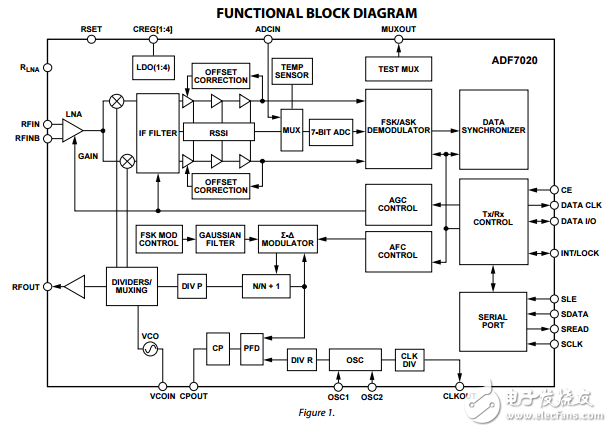
资料下载

ADF7020高性能的ISM频段FSK/ASK收发器IC数据表
The ADF7020 is a low power, highly integrated FSK/ASK/OOK transceiver designed for operation in the license-free ISM bands at 433 MHz, 868 MHz, and 915 MHz, as well as the proposed Japanese RFID band at 950 MHz. A Gaussian data filter option is available to allow either GFSK or G-ASK modulation, which provides a more spectrally efficient modulation. In addition to these modulation options, the ADF7020 can also be used to perform both MSK and GMSK modulation, where MSK is a special case of FSK with a modulation index of 0.5. The modulation index is calculated as twice the deviation divided by the data rate. MSK is spectrally equivalent to O-QPSK modulation with half-sinusoidal Tx baseband shaping, so the ADF7020 can also support this modulation option by setting up the device in MSK mode. This device is suitable for circuit applications that meet the European ETSI-300-220, the North American FCC (Part 15), or the Chinese Short Range Device regulatory standards. A complete transceiver can be built using a small number of external discrete components, making the ADF7020 very suitable for price-sensitive and area-sensitive applications. The transmitter block on the ADF7020 contains a VCO and low noise fractional-N PLL with an output resolution of 《1 ppm. This frequency agile PLL allows the ADF7020 to be used in frequency-hopping spread spectrum (FHSS) systems. The VCO operates at twice the fundamental frequency to reduce spurious emissions and frequency-pulling problems. The transmitter output power is programmable in 0.3 dB steps from −16 dBm to +13 dBm. The transceiver RF frequency and modulation are programmable using a simple 3-wire interface. The device operates with a power supply range of 2.3 V to 3.6 V and can be powered down when not in use. A low IF architecture is used in the receiver (200 kHz), minimizing power consumption and the external component count and avoiding interference problems at low frequencies. The ADF7020 supports a wide variety of programmable features, including Rx linearity, sensitivity, and IF bandwidth, allowing the user to trade off receiver sensitivity and selectivity against current consumption, depending on the application. The receiver also features a patent-pending automatic frequency control (AFC) loop, allowing the PLL to track out the frequency error in the incoming signal. An on-chip ADC provides readback of an integrated temperature sensor, an external analog input, the battery voltage, or the RSSI signal, which provides savings on an ADC in some applications. The temperature sensor is accurate to ±10°C over the full operating temperature range of −40°C to +85°C. This accuracy can be improved by doing a 1-point calibration at room temperature and storing the result in memory.

声明:本文内容及配图由入驻作者撰写或者入驻合作网站授权转载。文章观点仅代表作者本人,不代表电子发烧友网立场。文章及其配图仅供工程师学习之用,如有内容侵权或者其他违规问题,请联系本站处理。 举报投诉
- 相关下载
- 相关文章




